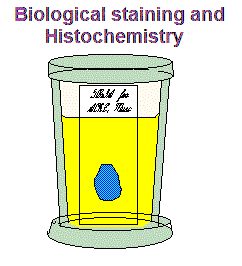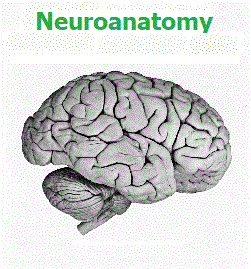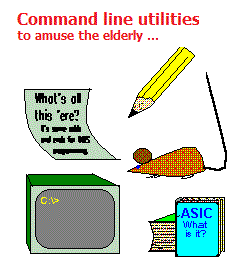


   |
Files containing directly available information (text, tables,
pictures)
will be opened and displayed if
you click on the link
Files with names of the form filename.zip are archives. When you click on a link to an archive you will be invited to download the file. Each archive contains several compressed files. To use a .ZIP archive you must download it and then decompress it. Recent versions of Windows (7, 10) include WINZIP and WINRAR, which do this well. PDF (portable document format) files require the Adobe Acrobat Reader. If you don't have this free program, click here to download it. Other free PDF readers include Foxit Phantom (Foxit Phantom) and SodaPDF (Soda PDF), both of which can also be used to create and edit PDF files.
Histochemistry etc.My research, from the 1960s to the 2010s, involved using histotechnology.1. Utilities for chemical calculations:
2. Practical instructions with explanations
3. Links to other web sites
Click here for more information about the histochemistry and histotechnology files and links for downloading. |
NeuroanatomyThe University of Western Ontario employed me for 39 years to teach this subject.
Click
here for
more information |
|
Command line utilities. These are for older people who still like to use DOS commands and batch files. They were written and compiled in the 1990s with ASIC (Version 5), a dialect of BASIC that generates small, efficient .COM or .EXE files. Each utility comes with an explanatory plain text file. Most also have built-in help. They work with the Windows Command Prompt (C:\_) but JPsoft's free Take Command alternative program is easier to use; their Version 9 is adequate, but they have many more recent versions for enthusiasts.To use these in 64-bit Windows (as on most laptops) it is necessary to install DOSBox, a free (public domain) emulation program. Click here for the latest version of DOSBox
| ||
..
..
..
..
..
..
..
..
..
..
..
..
..
..
..
..
..
..
..
| Utilities for chemical calculations.
These include three command-line programs that calculate data about entered
chemical formulae. For example, if you enter:
MW NaHCO3 the
formula and molecular weight
of sodium bicarbonate will appear on the screen as NaHCO3 84.00687. This result can be sent to a
comma-delimited database file if desired. With the solutions utility you could type SOLUTION H2NCONH2 6.5M and obtain the concentration of 6.5M urea in various units, including 39.04 grams per 100 ml. You can also use SOLUTION to obtain molarity from grams per litre or percent w/v. For a peptide sequence, PEP gly-lys-trp-arg tells you that this tetrapeptide has molecular weight 545.67 and that its pI is approximately 8.7. You will need to install the DOSBox emulation utility (free download) to run these utilities on a computer with 64-bit versions of Windows (Most laptops). They still (Jan 2024) work well with 32-bit Windows 10, with no need for a DOS emulation utility. |
Download chemical utilities. DOS version (66513 bytes) |
| FAQ: Staining, histochemistry and histotechnology. An indexed collection of frequently asked questions on 84 topics, grouped in 6 major categories. Some topics include more than one question and answer. Many are documented with references to books and other publications. Several people have contributed answers, many of which have appeared on the Histonet listserver. This FAQ is a single quite large file (220 KB) so it may take a minute or two to load by way of a slow internet connection. Once loaded, movement among its links is instantaneous. This FAQ is updated from time to time. | Consult the FAQ |
| Glossary of Staining Methods, Reagents, Immunostaining, Terminology and Eponyms. This is the largest online compilation of definitions in the field of histotechnology, maintained by the Biological Stain Commission on their website and updated from time to time by RW Dapson, RW Horobin and JA Kiernan. | Consult the BSC's Glossary |
| Keeping sections on slides. A review of the approaches to this old problem: positively charged slides (APES, polylysine); adhesives (especially chrome gelatin); and other tricks too. | Read about adhesives for keeping sections on slides. |
| Coating slides with nitrocellulose (= celloidin or collodion). Detailed instructions for encasing slides in nitrocellulose film to prevent removal of sections by harsh liquids such as alkalis and hot acids. Includes references. | Read how to treat slides with nitrocellulose. |
| Making your own aqueous mounting media. Instructions for making aqueous mountants. Why buy, when it's cheap and easy to make your own? Originally published in Microscopy Today, and reproduced with permission. | Recipes and instructions for 4 aqueous mountants. |
| Formaldehyde, paraformaldehyde and glutaraldehyde. What they are and what they do. A short review of how aldehyde fixatives work, with chemical schematics and references. Originally published in Microscopy Today, and reproduced with permission. | Read about formaldehyde and glutaraldehyde. |
| How to stain motor end plates. A brief overview, with references, of combined techniques for acetylcholinesterase activity and the terminal branches of motor axons in skeletal muscle. Originally published in Microscopy Today, and reproduced with permission. | Read about staining neuromuscular innervation. |
| Formaldehyde fixation and immunohistochemistry. An article that appeared in an NSH regional newsletter in 2005, explaining the actions of formaldehyde and why this fixative often impairs subsequent application of immunohistochemical methods. (PDF file) | Read about actions of formaldehyde on antigens |
| Antigen retrieval. Another article that appeared in an NSH regional newsletter in 2005, discussing procedures for unmasking antigens in sections of formaldehyde-fixed tissue. The possible mechanisms of several antigen retrieval procedures are discussed. (PDF file) | Read about antigen retrieval |
| Click here for some links to histological, histochemical and histotechnical web sites. |
..
....
..
....
....
..
....
....
..
....
....
..
Basic functional neuroanatomy. This concise (35 page PDF file) illustrated summary of the subject is for medical students and those in the allied health sciences who need to understand the normal nervous system and the rationale of some abnormalfunctions resulting from injury or disease. It is not a replacement for a textbook. | PDF file (1,862,897 bytes) revised January 2024. Basic functional neuroanatomy |
| Glossary of neuroanatomical and related terms, including eponyms. Available as a downloadable PDF file and also as an interactive HTML file with links. Both are updated from timeto time. | PDF file (prints as 36 pages, Jan. 2024) Online HTML access, with links etc. (Expect updates) |
| Anatomical foundations of neuroscience. This is an HTML file with links to more than 60 images. It is derived from handout notes (about 115 pages when printed) for a graduate course formerly given at the University of Western Ontario. The notes explain the cells of the nervous system, developmental and comparative neuroanatomy and regional and functional anatomy of the nervous systems of man, the rat and some other animals. | This file, with its links to pictures and tables of data, is designed to be read on screen. |
| Neuro-Slides. These are sets of images used in lectures to medical, allied health sciences and graduate students. Each set is a stand-alone .EXE file that displays the images on screen or with an LCD projector. (Needs Windows 9x, NT, 2000, XP, 7 or 10.) | Click here for a list of slide-shows with descriptions and instructions for downloading. |
| Dissection of the human brain. Instructions for dissecting the human brain may be read on-screen, or you may prefer to download the zipped text file. There are references to photographic illustrations in Barr's The Human Nervous System: An Anatomical Viewpoint, 10th edn by J. A. Kiernan & N. Rajakumar (Philadelphia: Lippincott, Williams & Wilkins, 2015 (ISBN 9781451173277). These photos show many stages of the dissection and also stained sections of the cerebrum, brain stem and spinal cord. | Dissection of the human brain (On screen) |
| Neuro Quiz. A collection
of about 300 questions, grouped by subject. Answer by typing a word or
short
phrase. The correct answer is then shown and explained. This program works well in 32-bit Windows 7 or 10, but DOSBox is needed with a 64-bit operatins system (as in most laptops). |
All the files from the NEUROQUIZ.ZIP archive must reside in the same directory. The command BQ starts the program. For more information read the text file BQ.DOC |
| Neuro-MCQ. About 140
multiple choice questions in Neuroanatomy. They can be chosen in groups
by subject
or at random from the whole collection. This program works well in 32-bit Windows 7 or 10, but DOSBox is needed with a 64-bit operatins system (as in most laptops). |
A single file, NMCQ.EXE, is all that is needed to run this program. |
Go back to John Kiernan's home page.